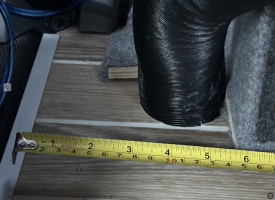Recently I had a diesel heater fitted to my van.
To cut a long story short I was talked out of having it fitted under the drivers seat and so it was fitted coming up through the floor behind the drivers seat.
It's further back than I imagined and will get in the way of the furniture units.
So what I would like to know is if I got the hot air duct re-routed to under the drivers seat would it be possible to repair / block up the hole that the hot air tube is currently entering the van. If so what is the best way? I am really looking for suggestions about the metal work. Once that is done I would be able to repair the hole in ply floor.
Pic to show where it is now:

To cut a long story short I was talked out of having it fitted under the drivers seat and so it was fitted coming up through the floor behind the drivers seat.
It's further back than I imagined and will get in the way of the furniture units.
So what I would like to know is if I got the hot air duct re-routed to under the drivers seat would it be possible to repair / block up the hole that the hot air tube is currently entering the van. If so what is the best way? I am really looking for suggestions about the metal work. Once that is done I would be able to repair the hole in ply floor.
Pic to show where it is now:


